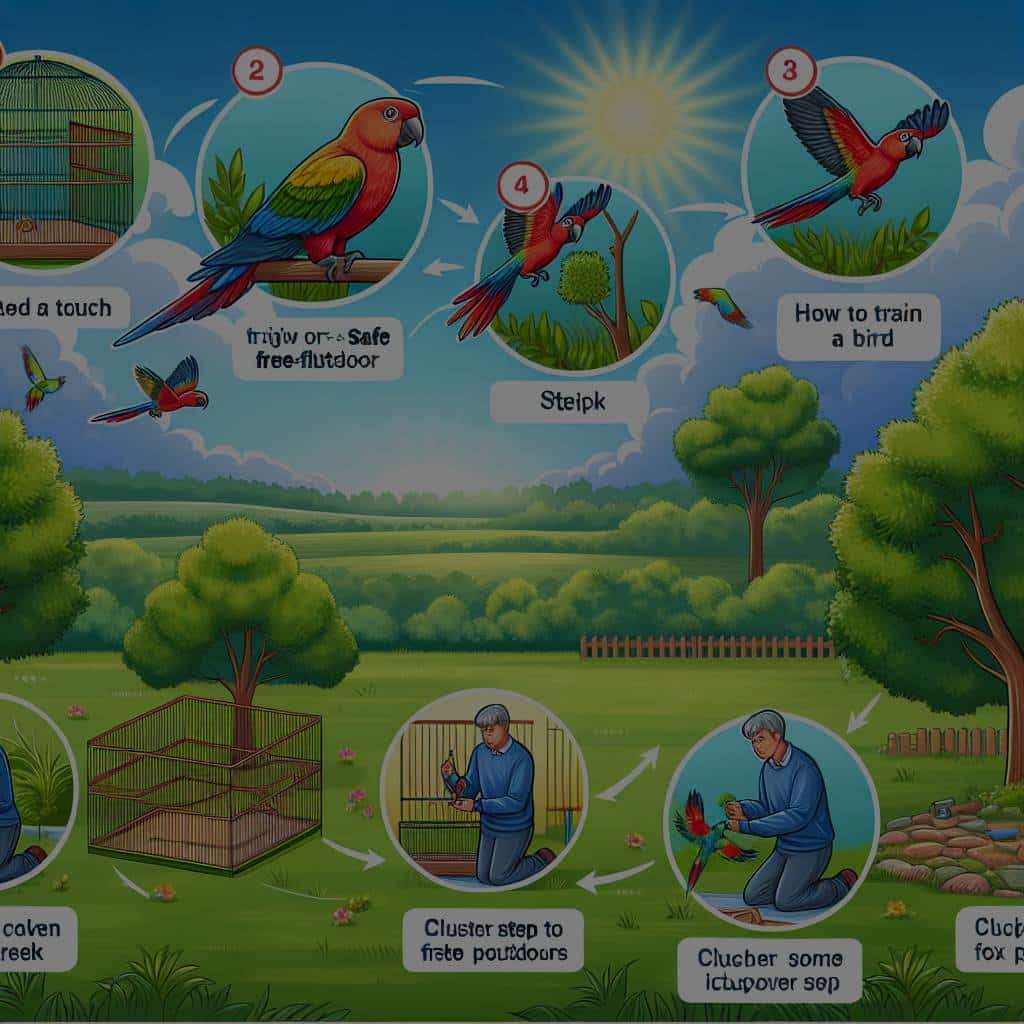How to Train a Bird to Safely Free-Fly Outdoors?

The vision of birds in flight has long inspired a sense of freedom in many people. From the wide-winged soaring of an eagle to the swift fluttering of a hummingbird, there is a grace and majesty about bird flight that is truly awe-inspiring. This may explain why many bird owners wish to provide their feathered friends with the chance to experience flight outside the confines of a cage. However, the idea of letting a pet bird free fly outdoors can be daunting. In this article, we will guide you through the process of training your bird to fly safely outdoors, with a focus on parrots and macaws, which are some of the most popular species kept as pets.
Training Your Bird for Safe Outdoor Flight
Training a bird, such as a parrot or macaw, for outdoor flight is a process that requires patience, consistency, and a solid understanding of bird behavior. Just as humans learn through a process of trial and error, so too do birds. Through training, you will help your bird develop the skills it needs to navigate the outdoors safely.
Additional reading : How to Create a Pet-Friendly Workspace When Working Remotely?
You should begin by establishing a recall, which is a command that tells your bird to return to you. Start with short distances in a controlled indoor environment. Over time, increase the distance and complexity of the recall, gradually moving to an enclosed outdoor area. Always reward your bird when it responds correctly to the recall. This could be with a favorite food, praise, or petting.
The Importance of Clipping Wings
Contrary to what you might think, teaching a bird to fly safely outdoors is not just about teaching it to fly. It’s also about teaching the bird when not to fly. This is where the question of clipping wings comes into play.
This might interest you : How to Perform CPR on Your Pet in Case of an Emergency?
In the early stages of training, it can be helpful to keep your bird’s wings clipped. This limits their flight capability and can make the training process easier. However, it’s crucial to understand that a clipped parrot can still fly, especially if frightened. It just can’t fly as well as it could with full wings. Remember, the goal is not to prevent flight but to control it during the initial stages of training.
Preparing for Outdoors: Understanding the Risks
Before taking your well-trained bird outdoors, it’s important to understand the potential risks and how to manage them. There is always a chance that your bird could fly off and not return, or it could be attacked by a predator. It’s your responsibility as an owner to minimize these risks.
One way to do this is to choose a safe environment for your bird to fly. Look for a large, open space away from roads and potential predators. Monitor the weather closely; avoid taking your bird out in high winds or bad weather that could make flying difficult. Also, consider the time of day. Early morning or late afternoon are often the best times for outdoor flying as it’s cooler and there are fewer distractions.
Dealing with Unexpected Situations
Even with careful training and planning, unexpected situations can arise when your bird is flying outdoors. Developing a plan to deal with these potential problems will help ensure your bird’s safety.
If your bird flies out of sight, stay calm. Use your recall command and listen for your bird’s response. Have a portable cage handy to secure your bird once it returns. If your bird doesn’t respond, it may have flown further than you think. Don’t give up; continue searching and calling for your bird.
If your bird is spooked or attacked by another animal, it’s important to intervene quickly. However, don’t rush in and scare your bird even more. Approach slowly and use your recall command. If your bird is injured, get it to a vet as soon as possible.
In conclusion, training a bird to safely free-fly outdoors requires time, patience, and understanding. It’s a rewarding process that can enhance the quality of life for your bird, giving it a taste of the freedom that its wild cousins enjoy. However, always remember that the safety of your bird should be your top priority, and it’s up to you to create a safe and enjoyable flying experience for your pet.
Harness Training: A Safety Measure
Harness training is another effective strategy to ensure the safety of your bird during outdoor flight. This method allows the owners to have control over their bird’s movement while giving them the freedom to fly. It’s particularly useful for large birds like the African grey or the greenwing macaw.
Start by getting your bird accustomed to the harness indoors. Begin by allowing your bird to explore the harness, letting it touch and play with it. Once the bird is comfortable with the harness, gently place it on the bird, rewarding it with treats or praise for its calm behavior. Gradually increase the amount of time your bird is in the harness each day, ensuring it’s comfortable and not causing any distress.
Remember, the harness should fit snugly, but not too tight. It should not restrict the bird’s movement or breathing. Always check for any signs of discomfort or irritation on your bird’s skin where the harness touches.
When your bird is comfortable wearing the harness indoors, you can start using it for short periods outdoors. Always monitor your bird carefully when it’s in the harness, paying attention to its behavior and any potential dangers in the environment.
Social Media and Free Flying Community
Sharing your bird’s free flight journey on social media platforms like Facebook and Instagram can be incredibly beneficial. Not only does it allow you to document your progress, but it also connects you with other free flyer enthusiasts and professionals who can provide valuable advice and support.
Communities of parrot owners engaged in free flying are aplenty on these platforms. They share tips, techniques, and experiences, making them a great resource for those interested in free flying their birds. You may also come across professional flight trainers who offer online courses or personal training sessions.
Remember, every bird is unique, and what works for one might not work for another. The shared experiences in these groups can give you a broader perspective and solutions for potential obstacles you might face in your free flight journey.
Conclusion
Undeniably, the journey to train a bird to safely free-fly outdoors is a lengthy and meticulous process that requires dedication, patience, and a deep understanding of your bird’s behavior. The use of recall training, harness training, and risk management strategies are key elements in ensuring the safety of your bird during free flight. The process may seem daunting, but the sight of your bird soaring freely and happily in the open sky makes it worth all the effort.
Engaging with the free flying community on social media platforms can provide valuable insights and support which can prove highly beneficial. Remember, as bird owners, it’s our responsibility to ensure the safety and well-being of our feathered friends. When done correctly, free flying can significantly enhance the quality of life for your bird, offering it a chance to experience the natural joy of flight. So, take the time, make the effort, and set your bird free!
